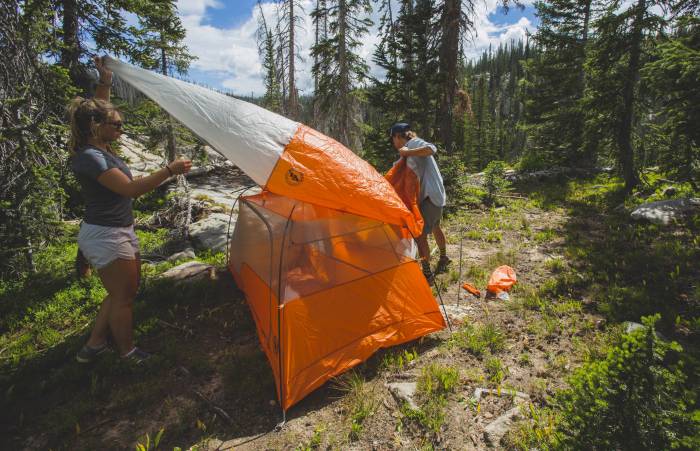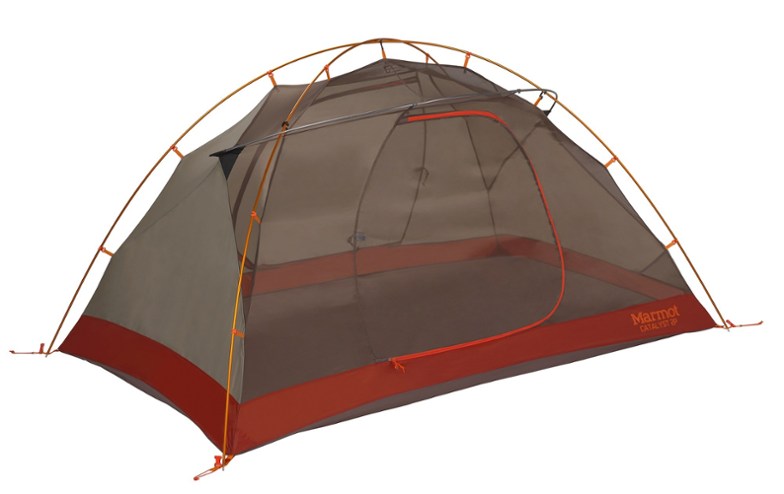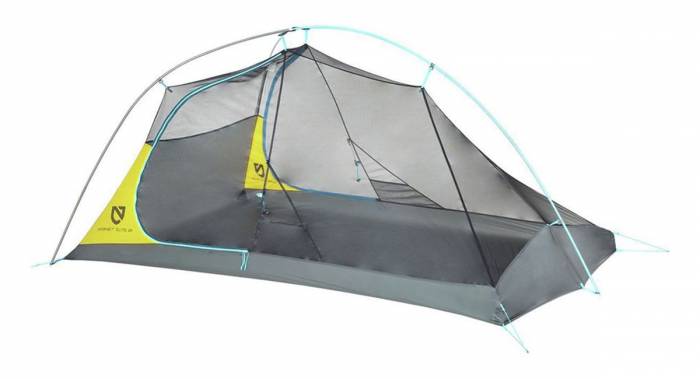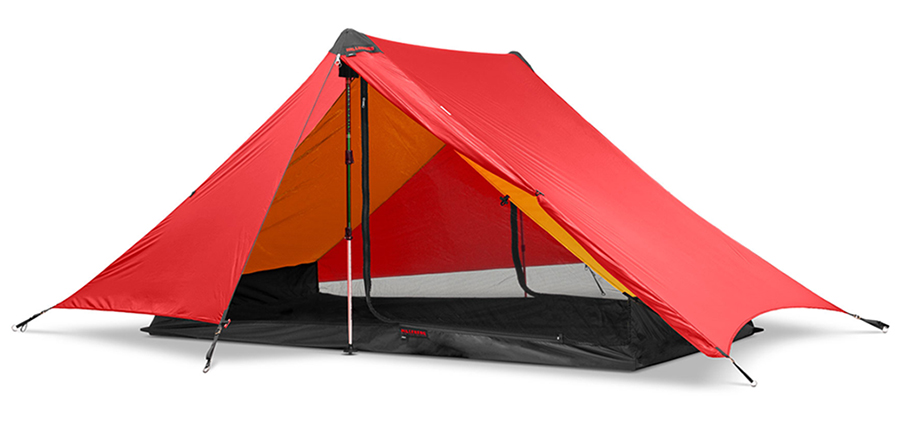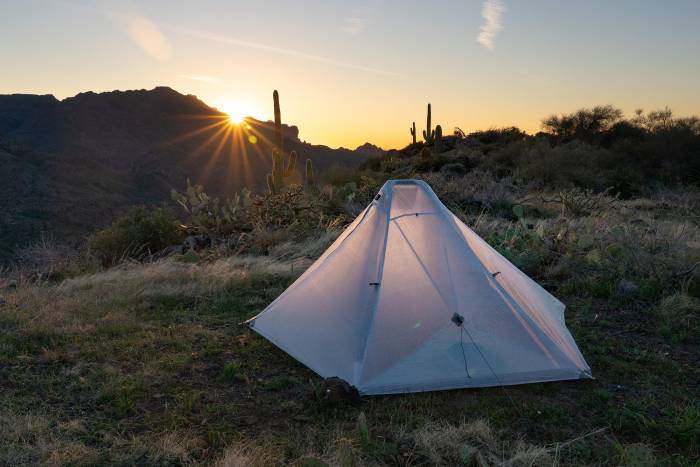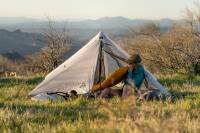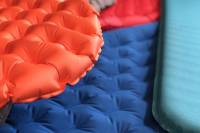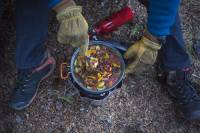Products You May Like
Whether you’re looking to spend 100 nights on the trail or stick to a tight budget, we’ve found the best backpacking tents of 2020.
A tent is one of the biggest investments you’ll make when getting into backpacking. And although sleeping bags and sleeping pads are arguably as important to a good night’s sleep, nothing gives you a home in the wilds quite like a good tent.
I’ve personally spent hundreds of nights in tents. And when it comes to picking a tent, one truth stands out: No single tent will work well for every situation. Sometimes you want a superlight bivy that just keeps the bugs away. Other times, you want a burly winter abode capable of standing up to gale-force winds and heavy snow.
So picking a tent largely comes down to how you plan to use it. If you need help deciding, check out our buyer’s guide at the end of this article. And if you’re looking for something roomier for car camping or family camping, we have a separate review of the best camping tents.
The Best Backpacking Tents of 2020
Best Overall Backpacking Tent: Big Anges Copper Spur HV UL2 ($450)
Do you know what’s awesome in rainy weather? Vestibule awnings to cook under. And the Big Agnes Copper Spur HV UL2 has them, plus a lot of other amazing details that set it apart from the crowd of backpacking tents. But let’s start with the basics.
This two-person, freestanding tent tips the scales at 3 pounds 2 ounces — or a trail weight of 2 pounds 11 ounces. That’s light enough to make it a contender even for the gram-counters, although tents definitely get lighter (see below). But at that weight, you get a really comfortable abode for the trail. It has two doors, two vestibules, 29 square feet of floor space, and 18 square feet of combined vestibule space.
The good overlap between the bathtub floor and the rainfly ensures a dry night’s sleep. Above the floor material, quality mesh gives a breathable, well-ventilated space that should keep condensation low.
While the Copper Spur HV UL2 has been a best-seller for Big Agnes for years, it made some big improvements for 2020. Namely, a 3D bin “mezzanine” at the foot provides ample elevated storage. Plus, it has an oversized ceiling pocket at the head and media pockets with cord-routing for electronics.
Other improvements include excellent and easy-to-use TipLok tent buckles on the corners as well as high-quality DAC Featherlite NFL and NSL poles with a prebent span pole and four-way high-volume hub design.
So yes, this tent will keep you protected from the elements when closed. But let’s get back to the nifty new feature many campers will enjoy: the vestibule awning. Using your trekking poles, the Copper Spur HV UL2 allows you to post up the vestibule door into an awning.
In light rain, this gives you a nice open space to cook or sit up out of the weather. It’s also nice for shade on a sunny afternoon. While you probably won’t use it every trip, the added bit of versatility helps set this otherwise great tent apart from the field.
Weight: 3 lbs. 2 oz.
Height: 40″
Pros: Light, stable, roomier than expected, excellent storage and vestibule design
Cons: Expensive
Runner-Up: MSR Hubba Hubba NX ($450)
The Hubba Hubba NX is, from our multiple tests and reviews, the best tent for a lot of people. It’s a big investment and a high-end design that has a lot to desire if you plan to spend plenty of time sleeping under the stars. Let’s dig in.
Mountain Safety Research’s flagship backpacking tent, the Hubba Hubba NX is a lightweight, freestanding, three-season, two-door, two-vestibule backpacking tent. You can get it in one-, two-, three-, and four-person sizes. We tested the two-person model.
The first thing that sets the Hubba Hubba NX apart are its poles. It uses Easton Syclone Poles, which are an extremely strong, durable, light composite material. We abused them for more than a year in testing, and they came out in great shape.
Next is the coating material on the fly and floor: MSR Xtreme Shield durable waterproofing. The brand claims it lasts three times longer than standard waterproof coatings. It has performed flawlessly in our tests.
The two-person model weighs in at 3 pounds 8 ounces, which puts it in the midweight category of backpacking tents. It’s certainly very light to carry but not ultralight by any means. However, it does pack down well and has one of the best stuff-sack systems we’ve used, making putting it away very easy.
Setup and takedown are simple and intuitive. We easily set it up for the first time in under 5 minutes, no instructions needed. With two doors, smooth YKK zippers, and 17.5 square feet of vestibule space, entry and exit are easy. You’ll also have plenty of space to store your gear while hiking. The tent has several pockets inside to stash your personal belongings.
A very cool feature, you can roll back the rainfly for stargazing and excellent ventilation. But if rain starts to fall, it’s quick and easy to close it from this configuration.
Overall, this tent fits the bill for a ton of activities. It’s burly enough for car camping, light enough to carry on a long backpacking trip, and built to last for many years.
The only real flaw is that it doesn’t come seam sealed from the factory. That means that before using it, you really should use the included seam sealer gel and coat all the seams.
For $450, we’d expect it to come from the factory sealed. But it’s not a dealbreaker for us, as the job is easy to complete in a backyard and gives you the chance to do a gear shakedown before using it in the field for the first time.
Weight: 3 lbs. 14 oz. (3 lbs. 8 oz. minimum trail weight)
Height: 39″
Pros: Light enough to backpack, tough enough for car camping
Cons: Expensive, must seam seal at home
Best Budget Backpacking Tent: Marmot Catalyst 2P Tent ($183)
At $183, the Catalyst two-person tent isn’t exactly cheap. But it’s a very good value for someone looking for a solid backpacking tent that will also fit the bill as a car camping tent.
At a minimum trail weight of 4 pounds 11 ounces, it’s on the heavy side of backpacking tents. But it’ll do the job and packs down small enough to fit comfortably in a backpack.
It’s quite spacious with 32.5 square feet of floor space. Buyers love the color-coded poles for easy setup, which most say is a piece of cake even for new campers.
It has two D-shaped doors with vestibules, adding room for gear storage. For new hikers getting into the game, this is a great place to start. It has a 4.25-star rating with 68 reviews on REI.com.
Weight: 4 lbs. 11 oz.
Height: 44″
Pros: Great value, spacious, easy setup with color-coded poles
Cons: Heavier than other backpacking tents
Best Ultralight Backpacking Tent: NEMO Hornet Elite ($500)
Our team has dozens of nights backpacking with the NEMO Hornet under our collective belts, and the consensus is clear: We love this tent! Mostly, we love how much this tent saves both weight and pack space. It’s a marvel of engineering. Here’s how it breaks down.
The NEMO Hornet Elite weighs a scant 2 pounds 1 ounce. And you can ditch some stakes and the stuff sack for a minimum trail weight of 1 pound 11 ounces. For gram-counters, that makes it a contender on weight alone.
But this tent is more than light. It’s also a very legit abode in bad weather. In rainy, stormy nights on the trail, the NEMO Hornet Elite 2 kept our testing team dry and comfortable. Unlike many ultralight options, this is a freestanding tent. It uses a clever three-pole design, mesh interior, and integrated rainfly for a tent that keeps out bugs, rain, and wind.
Inside, a 27.3-square-foot floor gives a small but acceptable space for two adults. This is certainly not a large footprint, and you will be shoulder to shoulder with your tentmate. But remember, we’re ultralight backpacking here. So snuggle up.
Fortunately, there is enough room under the two vestibules (serviced by two doors) for a large pack, shoes, and some other gear. We’ve used it many times in the rain, and it’s enough space to keep your kit dry, even in nasty weather.
Setup and takedown are also easy. Once familiar with the tent, my wife and I can usually set it up easily in less than 5 minutes.
Of course, at $500, the Hornet Elite is a significant investment. But we’ve used one for enough nights to be impressed with its durability. That said, this is a superlight silnylon tent. That means it won’t hold up to abuse, and we don’t recommend it for car camping, as that would put wear and tear on a very expensive tent.
But for those who want a lightweight tent to carry over big miles, the NEMO Hornet Elite is our favorite ultralight backpacking tent on the market right now.
Weight: 2 lbs. 1 oz.
Height: 37″
Pros: Ultralight, packs small, withstands weather
Cons: Expensive, fragile for car camping or sharp rocks
Versatile Ultralight Tent System: Six Moon Designs Haven Bundle ($335)
The cottage brand Six Moon Designs focuses on building very light equipment with long-distance hikers in mind. While quite specialized, the Haven Bundle is an easy-to-use trekking pole tent that tips the scales at just 2 pounds, 2 ounces, including a tarp and interior net. You can use the tarp alone on the trail, which, for 17 ounces of packed weight, gives you a large 53 square feet of shelter.
Or, if you’re in a buggy locale, add the Mesh Nest inside of the tarp for even more protection. The nest is 48 inches wide and 114 inches long, providing plenty of space for two adults. In this configuration, you end up with two large vestibules and two doors.
At $335 for the package, it’s a fairly priced ultralight tent. And thanks to the ability to be set up as a tarp alone, the system packs a lot of versatility and can stretch from fast-and-light missions to more leisurely base camps.
It’s held back mostly by the ultralight fabrics that limit durability. And as with a lot of trekking pole tents, because it’s not freestanding, it’s a little trickier to set up and requires good guyline attachments for stability.
Weight: 2 lbs. 2 oz.
Height: 45″
Pros: Ultralight, packs small, can function as a tarp alone at just 17 ounces
Cons: The 30-denier fabric is somewhat fragile, requires hiking poles (or a pole kit, purchased separately for $30 to $80) to set up
See the Six Moons Haven Bundle
Favorite of Serious Backpackers: Tarptent Double Rainbow ($299-329)
Weighing in at 2 pounds 10 ounces, the Tarpetent Double Rainbow commands a cult-like following among consumers. That’s because this very light tent provides a great amount of usable interior space (88 x 50 inches), two doors, and two vestibules.
Users love the aerodynamic shape that helps it shed wind and rain. Many note that it handles storms better than other lightweight tents.
One unique add-on for the Tarptent Double Rainbow is the clip-in liner. While it adds very little weight, it adds warmth in winter or cooling in summer. But even better, it protects against condensation droplets getting knocked onto sleeping campers by wind or heavy rain, keeping the inside of the tent drier.
Weight: 2 lbs 10 oz.
Height: 40″
Pros: At 7’4″ long, this is an excellent choice for taller campers
Cons: The semi-freestanding design does require stakes to remain upright
See the Tarptent Double Rainbow
Modernized A-Frame Tent: Hilleberg Anaris ($595)
Hilleberg builds exceptional tents with high-quality materials, and the Anaris is no exception. However, Hilleberg tents carry high prices and a little more weight than their competitors. That’s not a mistake, as the brand aims to be a literal heirloom that users can pass down generation after generation.
The Anaris is one of the more affordable, and lighter, Hillebergs on the market, and we love both its utility and versatility. At 3 pounds 1 ounce, it’s light enough for backpacking. It uses trekking poles instead of tent poles for setup. The design is very clever, allowing the user to roll up one or both sides of the rainfly for incredible ventilation on warm nights.
But as temps drop or rains fall, you can extend the rainfly and hunker down. Want a more minimal shelter on some trips? The outer tent alone functions as a tarp with full functionality of rolling away walls and vestibule doors yet weighs just 1 pound 7 ounces.
It’s a reasonably spacious two-person model at 28 square feet and adds two vestibules with 9 square feet of storage. With durable Kerlon 1000 fabric and a 70-denier floor, this minimalist tent is built to last.
Weight: 3 lbs. 1 oz.
Height: 41″
Pros: Durable, versatile, excellent ventilation
Cons: Expensive, requires trekking poles for setup
The Best of the Rest
REI Quarter Dome SL 2: $349
The REI Quarter Dome SL 2 is a very popular, affordable tent. It’s well-rounded for car camping and backpacking. With a minimum trail weight of 2 pounds 8 ounces, this tent hits a sweet spot that should appeal to a broad cross-section of hikers and campers.
The freestanding Quarter Dome SL 2 sets up quickly and easily. The main tent body has tons of mesh and a small bathtub floor that extends slightly above the overlapping rainfly. It stays dry in rainstorms but could see a little splash-over from runoff.
Two large doors give each camper easy access to the interior or the vestibules on each side. It’s a snug layout for two, but it should suffice as long as you and your partner don’t mind being cozy.
Four pockets in the mesh provide adequate storage for small items. Overall, it’s a nice design but probably not great for heavy storms. We liked this model, especially at the reasonable price point, as a versatile tent at a very light weight.
Given the massive amount of mesh, it should be a strong contender for hot, dry climates where ventilation and protection from insects are top priorities.
Weight: 2 lbs. 8 oz.
Height: 38″
Pros: Value, lightweight, plenty of ventilation
Cons: Tight fit for two people
Kelty Late Start 2 ($160)
If price is your primary concern when buying a tent, but you still want good quality, the Kelty Late Start 2 is a good place to look. At $160, the Late Start 2 is far from the cheapest tent on the market. However, it’s a very nice tent that will last for several seasons while hitting a price point that most people won’t balk at.
The Late Start 2 packs down to 16 x 7 x 7 inches. While certainly not tiny, it will work in a backpack. Similarly, at a minimum weight of 4 pounds, it’s not ultralight but works for short backpacking excursions.
It sets up super fast with a simple two-pole design. Once up, the bathtub floor offers a slight overlap with the rainfly, so splashback could be an issue in heavy rain and wind. It has small vestibules barely big enough for a single backpack, but they will suffice for hikers on a budget. And two small pockets offer space to stash a couple of important items.
There are better tents out there, but you’ll pay more for them. For $160, this one is a value that should last through lots of happy camping.
Weight: 4 lbs. 8 oz.
Height: 40″
Pros: Good value, easy setup, quality construction
Cons: Heavier, not built for extreme weather conditions
Hyperlite Mountain Gear Dirigo 2 Dyneema Tent ($795)
The Hyperlite Mountain Gear Dirigo 2 Dyneema Tent is incredible, but it’s also super expensive. So while we do love this model for several reasons, it comes with a caveat of a $795 price tag.
But for serious hikers, the hefty investment may be worth it. Hyperlite builds the Dirigo 2 with Dyneema fabric, an extraordinarily durable material that withstands tons of abuse yet remains incredibly light.
This tent, which uses trekking poles for support, weighs in at just 1.75 pounds. It provides a floor area of 32.5 square feet and a vestibule area of 28.2 square feet for plenty of space for two hikers and packs.
While expensive, this is a top tent that will last a very long time. If you’re looking for an ultralight tent that will give you many seasons of use, this one is worth considering. For more, check out our full review of the Dirigo 2.
Weight: 1 lb. 12 oz.
Height: 45″
Pros: Ultralight, very strong
Cons: Expensive, trekking pole tents aren’t for everyone
See the Hyperlite Mountain Gear Dirigo 2
SlingFin Portal ($485)
The SlingFin Portal is one of the few tents we’ve tested that’s light enough for backpacking (with a trail weight of 2 pounds 13 ounces) but sturdy enough for legitimate winter camping. And while the brand bills it as a three-season tent, we’re so impressed with the design that we wouldn’t hesitate to pull it out when the snow flies.
Inside, the floor area of 27.45 square feet is sufficient for two adults. But it’s what’s on the walls that sets this tent apart. There, you’ll see internal guylines that reinforce the tent’s strength under higher wind or snow loads.
Other noteworthy features include extra zipper sliders (as a backup in case one gets damaged), 10 guy-out points, high-quality DAC NFL poles, and a pole swivel instead of a hub that keeps the long poles intact, increasing structural integrity and potential lifespan.
Our tester summarized this tent in four simple words: “This tent is killer.” And he meant it in the best possible way. Check out the full SlingFin Portal review.
Weight: 3 lbs. 4 oz. (trail weight 2 lbs. 13 oz.)
Height: 44″
Pros: Most versatile tent on the market, useful for all four seasons
Cons: Expensive
How to Choose a Backpacking Tent
A tent is a big investment, so it pays to figure out what you need. Below you’ll find a list of important considerations. But before we get there, take a moment to imagine your camping future.
Do you plan to camp alone or with your family? Are car camping tents your jam, or do you regularly head out for weeks in the backcountry? Are you strictly a summer camper, or do you sleep outside all year long?
There’s no right or wrong answer, but being clear on how you want to camp will make choosing a tent easier.
Space & Capacity
Interior space in a tent equals comfort. The main things to consider are floor dimensions and ceiling height. Tents have a stated number of people they sleep, but how roomy or cramped they will be at capacity varies. By paying attention to floor dimensions, you can get a better idea of how many sleeping pads will fit.
When backpacking, plan to save weight by being willing to snuggle into a two-person tent. But when family or car camping, we often find subtracting a person or two from the stated capacity maximizes comfort.
Ceiling height may not seem important — until the weather turns and you find yourself hunkered down inside for 6 hours. At that point, you’ll be happy you’re able to at least sit up comfortably and perhaps even stand in the bigger family tents.
Weight & Packed Size
If you only plan to car camp, weight and packed size aren’t major concerns. But anyone planning to haul their tent into the backcountry should take a hard look at these factors.
A tent like the 2-pound 1-ounce NEMO Hornet Elite is a great option for backpacking. It doesn’t take up a lot of space or weight in your pack, meaning you can justify bringing a favorite flask or a few extra snacks.
Weather Resistance
This is one of the biggest reasons to invest more in a tent. Basic tents handle pleasant weather like a champ and can even manage light rain and wind. But if you plan to camp during storms (which often roll in unexpectedly), it’s worth it to save up and buy a sturdier tent.
Premium tents have stronger poles, full rain covers, and sealed seams. And it’s things like this that seem less important — until you find yourself riding out an epic storm from the confines of your tent.
Value
The value of a tent investment often has to do with how often you camp. If you camp every weekend, spending $450 on a bomber tent could be worth it. This is especially true if you plan to camp into the colder seasons and need a tent built to withstand the weather.
On the other hand, if you’re just starting out or plan to camp only a few nights each summer, a budget pick like the $160 Kelty Late Start 2 will help you sleep outside without breaking the bank.
Have a favorite backpacking tent we missed? Let us know in the comments for future updates to this article.

